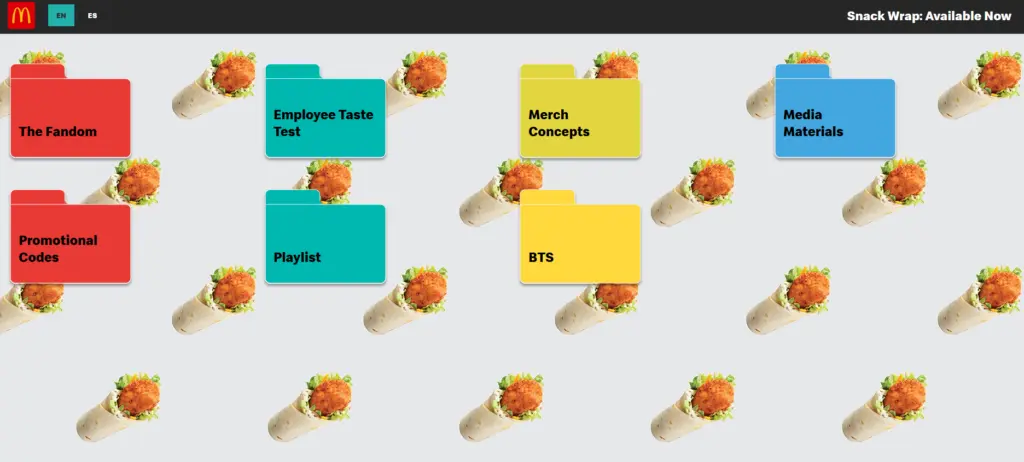- Emotional Resonance: Reviving a beloved item can spark deeper engagement than brand‑new launches.
- Integrated Storytelling: A cohesive, nostalgia‑driven campaign across digital, OOH, and social multiplies impact.
- Competitive Catalyst: One comeback can trigger categorywide innovation from rival brands.
- Consumer Voice: Listening to fan feedback—both cheers and gripes—sharpens future reintroductions.
- Scarcity & Hype: Limited‑time availability and pre‑announcement build the urgency that fuels FOMO.
A look at how McDonald’s turned a discontinued menu item into a modern limited‑time sensation
When McDonald’s quietly confirmed that the Snack Wrap would make its comeback, few could have predicted the groundswell of anticipation that would follow. Originally introduced in the mid‑2000s, the crispy‑chicken‑and‑tortilla bundle earned a devoted following before fading from menus.
Yet, whispers of its return sparked genuine excitement, driven by memories of after‑school treats and midday pick‑me‑ups. By tapping into that reservoir of fond recollections, McDonald’s harnessed a powerful marketing force: nostalgia.
Across generations, food often serves as a portal to simpler times. McDonald’s recognized this and seized the moment to rekindle the emotional connection customers held with the wrap. Rather than merely reissuing an old item, the brand crafted an entire narrative, one that honored the past while speaking directly to today’s consumers.
Building the Hype for the Snack Wrap
Months before the Snack Wrap hit trays again, McDonald’s set the stage with strategic teasers. A dedicated microsite revived the early‑aughts web aesthetic, complete with pixelated graphics and retro jingles reminiscent of the chain’s heyday.
Visitors who landed on the page found more than product details; they were invited to relive memories—scrolling through archived ads, sharing throwback stories, and even downloading vintage wallpapers.
Television spots followed, casting a nod to the wrap’s origins while infusing it with modern vigor. A familiar voiceover evoked Saturday morning cartoons as shots of the wrap in its original packaging gave way to sleek, contemporary close‑ups.
Social media amplified the buzz, with influencers unboxing mock‑vintage McDonald’s bags and playfully comparing first‑bite reactions across eras. By consistently weaving nostalgia into each touchpoint, McDonald’s made the wrap’s revival feel both inevitable and irresistible.
@how.kev.eats Honest Review of the McDonald’s snack wraps #foodreview #mukbang
The Multi‑Channel Nostalgia Machine
McDonald’s didn’t stop at digital nostalgia. Out‑of‑home ads recreated familiar drive‑thru scenes, but with a twist: the cast of characters now included Millennials and Zoomers who had grown up on the wrap’s legacy. Subway stations and city buses bore images of the wrap rendered in a retro poster style, while select stores received window decals evoking the snack’s original packaging art.
@asapliu The snack wrap is back what dreams are made of. #ad @McDonald’s
Inside the brand’s mobile app, a new “Snack Wrap Throwback” filter let users superimpose themselves into classic McDonald’s commercials, complete with floppy haircuts and neon tracksuits.
This playful activation not only engaged app users but also drove more mobile orders as fans tested the filter before placing their own wrap orders. By marrying old and new media, McDonald’s ensured the campaign reached across demographics and channels.
Rival Wrap Wars
No marketing spectacle occurs in isolation, especially in the fiercely competitive chicken category. As McDonald’s stoked nostalgia, competitors seized the moment. Rival chains rushed to unveil their own wrapped‑chicken offerings, framing them as fresh takes on a returning icon. The ensuing sparring—diss tracks generated by AI, cheeky social‑media jabs, and limited‑time value deals—transformed what could have been a quiet menu update into a full‑blown chicken wrap wars.
Yet this flurry of activity only reinforced McDonald’s strategy. Every tweet from a competitor reminded consumers that the Snack Wrap was back, cementing its place in the conversation. Instead of shying away from the comparison, McDonald’s leaned into it, launching playful social posts that challenged fans to weigh in on wrap supremacy.
By inviting side‑by‑side comparisons, the brand positioned its own offering as the gold standard for wrapped chicken, further fueling interest.
Listening to the Fans
Perhaps the campaign’s most nuanced move was McDonald’s willingness to listen—and adapt. As social channels lit up with praise, fans also voiced desires to see additional flavors from past eras.
Ranch? Barbecue? Honey Mustard?
McDonald’s monitored the chatter and teased that future limited‑time releases might expand flavor options, signaling responsiveness to customer feedback.
This dialogue underscored a broader point: nostalgia works best when it’s authentic and collaborative. By acknowledging fan suggestions, McDonald’s transformed passive consumers into active participants in the brand story.
The result was a two‑way conversation that deepened loyalty and set the stage for further nostalgic revivals beyond the Snack Wrap.
Marketing Lessons from the Wrap
The success of the Snack Wrap comeback offers several takeaways for marketers across industries.
- First, heritage products carry inherent emotional value that can outshine even the flashiest new launches. When reissuing a legacy item, it pays to honor its roots—inviting customers to revisit their fondest memories while introducing modern enhancements that speak to current tastes.
- Second, a truly integrated approach amplifies impact. Digital nostalgia portals, OOH visuals, social filters, and in‑store promotions all worked in concert to ensure no audience segment was left untouched. Consistency in tone and design created a cohesive experience, making every activation feel part of a unified campaign.
- Finally, embracing competitive noise can be a boon, not a threat. By owning the category conversation, McDonald’s allowed rivals to trumpet their own wraps while subtly reinforcing why the original snack held the crown. Encouraging comparison—whether through tongue‑in‑cheek posts or customer polls—kept the brand front and center.
The Future of Throwbacks
As economic pressures lead consumers to seek both value and comfort, retro offerings will likely remain a powerful tool. McDonald’s has shown that nostalgia, when paired with strategic innovation and genuine engagement, can drive foot traffic, earn media coverage, and spark social‑media fervor.
Whether it’s next year’s reappearance of another fan favorite or an entirely new twist on a classic, the Snack Wrap’s revival stands as proof that the past still holds tremendous marketing potential. And for McDonald’s, this is just the beginning of a broader playbook on how to turn golden‑arched memories into modern‑day success.




